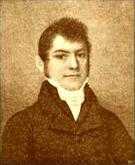Édouard Bovet

Édouard Bovet (1797–1849) was a Swiss watchmaker and founder of the Bovet Fleurier watch company.[1]
Life
Édouard Bovet was born in Fleurier in Neuchâtel, the son of Jean Frédéric Bovet, in 1797. Although the "Genève" tag is virtually compulsory for Swiss prestige name watches in the highest price bracket, it is the lesser known place name "Fleurier" that graces the watches from the Bovet company in Geneva: for the Bovet originated from this village in the Val-de-Travers, to the west of Neuchâtel. Watchmaking was introduced there between 1730 and 1740 by David Vaucher, probably a pupil of the legendary Daniel JeanRichard. The number of watchmakers in the Val-de-Travers grew very rapidly in the first half of the 19th century. The lace making that had provided work for a good third of the people living in the valley had been replaced by the much lower cost production on jacquard machines in France and Flanders.
Four more sons and a daughter were born in the following years. After completing his apprenticeship as a watchmaker, Edouard Bovet and two of his brothers moved to London, then the center of watch assembly and the watch trade in 1814.[2]
In China 1818-1830
He found a job at once, with the Magniac company who sent him to Canton in 1818 as watch repairer; this was the sole Chinese port that tolerated European merchants and businessmen - the so-called “red-haired barbarians”. In Canton in 1818 where he set up in business in partnership with his brothers in 1822. The enterprise, that had luxury watches made in Switzerland for export to China, was a resounding success.[3][4]
The flourishing watch trade with China prompted Edouard Bovet to set up on his own company in 1822: he founded a general partnership with the two brothers in London and one brother who had remained in Fleurier; the fourth and youngest brother also entered the business. Soon every first class watch in China with a high practical value and elegant exterior was simply called "Bovet" (pronounced "Boway" or read backwards "Tevob"). Pearl ornamentation and enamel miniature painting carried out in Geneva on Bovet watches ensured first class aesthetics at prices that, in contrast to the exaggerated luxury watches of the time, were affordable, at least for the upper class.
For years a Bovet watch was considered an asset in China and was accepted in payment everywhere. The movement was frequently finely engraved and chased and could be observed through a glass cover at the back. The central second hand that jumped every second, like modern quartz watches, was a Bovet specialty. Bovet adapted its production to the Chinese tradition of making gifts of valuable objects (statues, vases, horses even concubines) in pairs. So he could often sell two identical watches at the same time: if one failed, there was a replacement to hand. But Bovet’s enamel painters found it very difficult to paint two identical but mirror-image miniatures.
Return to Fleurier
Edouard Bovet returned to Fleurier in 1830 as a made man, accompanied by his four year old half-Chinese son Edouard-Georges. At that time it was customary for the European merchants in China to take a "temporary" wife for the duration of their stay. If children were born of this liaison, the father had to accept full responsibility. As a fervent republican, Bovet exposed himself in the abortive Neuchâtel revolution against Prussian rule in 1831. The house that his brothers had built for him in Fleurier according to his written instructions from China had to remain empty for the time being. Bovet had to move to Besançon where he continued watchmaking with the help of other exiled watchmakers.
Legacy
Edouard Bovet’s brothers and nephews - all of them shareholders in the company - made sure that the cornerstones of the Bovet empire in Fleurier, London and Canton continued to flourish. Once the political situation was back to normal, in 1840, the firm was re-registered as Bovet Frères et Cie.; the share capital amounted to 1 million francs. Edouard Bovet died in 1849; he lived long enough to witness the triumph of the republic and the withdrawal of the Prussians in the previous year. The succession was settled and the production for China continued; in 1855 Bovet was awarded a gold medal at the world exhibition in Paris for an absolutely identical pair of watches ordered by the emperor of China.
Two generations later the Bovets were running a flourishing Swiss-Chinese commercial enterprise and were no longer interested in watchmaking. The name was sold several times and relaunched in 1994. The current Bovet watches are modeled on their luxury precursors from the 19th century and look like pocket watches for the wrist.
References
- ↑ Conso - Marque Bovet "1818 : Édouard Bovet arrive à Canton, le seul port chinois ouvert aux étrangers et vend quatre montres de 10.000 francs. 1822 : Édouard et Alphonse Bovet créent la société de montres Bovet."
- ↑ Reyne Haines Vintage Wristwatches 2010 - Page 27 "BOVET This maker was founded in London in 1822 by Edouard Bovet, the son of watchmaker Jean-Frederic Bovet. Edouard studied watch making in London in 1814.
- ↑ Arts of Asia: Volume 27, Issues 5-6 1997 "For Edouard Bovet was a watchmaker and he had brought with him to China a consignment of his speciality products, at a time when such novelties were in increasing demand at the Imperial Court in Beijing and among the wealthy elite in ..."
- ↑ Catherine Pagani "Eastern magnificence & European ingenuity": clocks of late ... 2001 - Page 189 "Bovet, Edouard (1797-1849), Fleurier. Edouard Bovet went to London in 1815. In 1818, he went to Canton, where in 1822, he started a society for commerce in watches in China with his brother Alphonse. The society lasted until 1864."